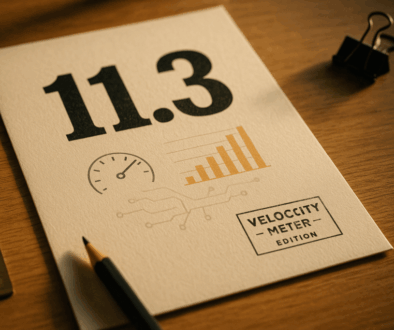Your AI strategy is killing your valuation
⚠️ The AI Commodity Trap: Why Your Efficiency Gains Are Making You Less Valuable
Here's the uncomfortable reality most mid-market executives won't admit: you're using AI to make your company more efficient and less differentiated at the same time. While you're celebrating 20% cost reductions, your competitors are using the same technology to build market positions you can't replicate.
The numbers tell the story. Software M&A jumped 78% this year, with private equity specifically targeting companies to rebuild for AI-first operations. Translation: acquirers are separating companies into two categories—those using AI to cut costs, and those using AI to create defensible value. Guess which ones command premium multiples.
This isn't theoretical. McKinsey's research on AI in software development shows that top performers are 6-7x more likely to scale AI across multiple use cases—not because they have better technology, but because they've fundamentally reframed what they're building toward. They're not optimizing existing workflows. They're creating new revenue streams that didn't exist six months ago.
Your board is asking about AI strategy. Your investors want to see ROI. But the real question isn't "How much are we saving?" It's "Are we building the kind of AI-enabled business someone would pay a premium to acquire?" Most companies are accidentally choosing the wrong answer.
Let's dive in.

⚡️ Why Efficiency-First AI Strategies Destroy Enterprise Value

The pattern shows up in every mid-market AI conversation: executives frame AI investments around headcount reduction, process automation, and operational efficiency. It sounds responsible. It satisfies CFOs. It's also the fastest way to commoditize your business.
Here's why. When you use AI exclusively for cost reduction, you're essentially making yourself interchangeable. Every competitor in your category can deploy the same efficiency tools, achieve similar cost structures, and compress margins industry-wide. You've just automated your way into a race to the bottom.
EY's analysis of high-performing AI adopters exposes the strategic divergence. The companies creating asymmetric value aren't asking "How do we do existing work cheaper?" They're asking "What can we do now that was structurally impossible before?" That question unlocks entirely different use cases—and entirely different valuations.
Consider finance operations. ISG research shows that agentic AI can cut BPO costs by 60%. But Citibank and similar institutions aren't stopping there. They're redeploying that capacity into market intelligence, scenario modeling, and strategic analysis that creates decision-making advantages. One approach saves money. The other builds competitive moats.
The difference compounds. Efficiency-focused organizations hit a ceiling within 18-24 months—they've automated what they can, achieved marginal gains, and now face diminishing returns. Growth-focused organizations find AI creates accelerating advantages as they enter markets they couldn't serve profitably, develop products faster than competitors can match, and deliver experiences that create genuine switching costs.
EY's AI Engine Room didn't upskill 230,000+ professionals to reduce headcount. They did it to enable each person to operate at strategic levels that were previously reserved for senior leadership. That's the tell. When AI creates capacity, what you do with it determines whether you're building enterprise value or just managing costs.
The retail sector makes this stark. BCG's research on AI-first retailers found that 40% of major retailers now have senior AI leadership roles—and two-thirds of consumers already use AI in shopping. The retailers treating AI as an IT project are watching market share erode to competitors who've made it a strategic capability. Walmart isn't using AI to do retail better. They're using AI to redefine what retail can be—and capturing customer relationships that traditional retailers can't match.
📌 Bottom Line: Private equity is paying premium multiples for companies that use AI to create market advantages, not companies that use AI to match industry benchmarks. Your AI strategy is either building enterprise value or destroying it. There's no neutral position.

🏭 AI Across Industries

🏭 Manufacturing: Configuration Intelligence as Competitive Weapon
Manufacturing AI used to mean preventing downtime. Now it means entering markets faster than competitors can respond. Configit's 2026 predictions show how leading manufacturers use AI for configuration intelligence—identifying which product variations are both market-viable and economically feasible before committing resources.
This isn't incremental improvement. It's structural advantage. Manufacturers with AI-powered PLM/ERP integration can test market viability, optimize production paths, and launch product variations at software-company speeds. Traditional manufacturers spend months on configuration decisions. AI-enabled competitors make those decisions in days and capture market opportunities that disappear before slower players can mobilize.
The knowledge transfer angle matters too. As experienced workers retire, companies face a brutal choice: lose institutional expertise or capture it systematically through AI. The companies solving this aren't just preserving knowledge—they're making it actionable across the organization, creating consistency that becomes a quality differentiator.
📌 Takeaway: Mid-market manufacturers who don't invest in unified data architectures and AI-powered configuration tools will find themselves structurally unable to compete on speed-to-market. That's not a technology gap—it's a strategic gap.
🛍️ Retail: The AI-First Separation Is Already Happening
BCG's research doesn't mince words: AI isn't coming to retail—it's already rewritten the rules. Two-thirds of consumers use AI in shopping. The retailers who treat this as a technology upgrade rather than a business model transformation are already losing.
The separation is visible in leadership structures. AI-first retailers have elevated AI to C-suite authority with budget control and strategic mandate. They're reinvesting efficiency gains into data infrastructure that enables hyper-personalization, real-time pricing, and predictive merchandising. Traditional retailers are running AI pilots that deliver marginal improvements while their customer base migrates to experiences they can't deliver.
Walmart, Starbucks, Sephora—the pattern holds. They're not using AI to improve retail. They're using AI to solve customer problems that couldn't be addressed profitably before. Each solved problem creates customer loyalty that price competition can't disrupt.
📌 Takeaway: If you don't have AI leadership with C-suite authority and strategic budget control, you're not building an AI strategy. You're funding IT projects while your market position erodes.
🏥 Healthcare: Clinical Intelligence Drives Retention and Revenue
Healthcare organizations face a retention crisis that AI can solve—if they frame it correctly. Wolters Kluwer's analysis shows that GenAI reducing administrative burdens isn't just an efficiency play. It's a retention strategy that directly impacts revenue.
The connection: clinician burnout drives turnover, which destroys continuity of care, which degrades patient outcomes, which erodes reputation and referral networks. AI that gives clinicians time to practice medicine instead of wrestling documentation doesn't just save costs—it protects the clinical relationships that drive sustainable growth.
Mid-market healthcare organizations using AI to improve both clinical outcomes and clinician satisfaction are solving for differentiation in a market where talent and reputation determine sustainability. That's a growth play disguised as operational improvement.
📌 Takeaway: Measure AI success by clinician retention rates and patient engagement scores, not just efficiency metrics. Those are the indicators that predict revenue stability and market position.
📦 Logistics: Predictive Operations Create Contract Advantages
DHL's deployment of AI agents handling hundreds of thousands of emails isn't about communication efficiency. It's about freeing logistics professionals to build the relationships and solve the problems that win long-term contracts.
The strategic insight: AI-driven visibility and predictive analytics create service guarantees that pure price competition can't match. When you can predictively manage delays, optimize routes dynamically, and communicate proactively about issues, you're not competing on price—you're competing on reliability. That changes contract economics entirely.
📌 Takeaway: Track AI ROI in contract win rates and customer retention, not just operational metrics. Those numbers tell you whether AI is creating competitive separation or just matching industry standards.

📈 AI by the Numbers

⚡ 92% productivity advantage for daily GenAI users versus 58% for infrequent users, PwC's 2025 Global Workforce Survey reveals. But only 14% of workers use GenAI daily. The implication: companies that don't systematically drive daily usage are leaving 34 percentage points of productivity gains—and competitive advantage—on the table.
💰 60% BPO cost reduction achievable through agentic AI in finance operations, according to ISG. Major institutions are already implementing autonomous agents for transactional work. Mid-market CFOs who don't understand this shift will find themselves structurally disadvantaged in capital efficiency within 24 months.
📈 6-7x scaling advantage for top AI performers who deploy across four or more use cases versus companies stuck in pilot mode, McKinsey reports. These leaders achieve 16-30% productivity gains and 31-45% quality improvements. Scale separates strategic winners from perpetual experimenters.
🎯 57% of insurance executives list AI as their top investment priority for 2026, with 54% identifying agentic AI as most transformative, Insurance Journal research shows. The focus: enabling advisors to concentrate on high-value relationships while AI handles process efficiency. That's growth strategy, not cost strategy.
🏪 78% surge in software M&A driven by AI disruption, with private equity deal volume doubling, per RBC analysis. Acquirers are specifically targeting companies to rebuild for AI-first operations. Your AI maturity isn't just affecting operational performance—it's directly impacting enterprise valuation.

📰 Five Headlines You Need to Know

💼 PE Firms Hunt AI Transformation Targets — Private equity is stepping in to capitalize on AI disruption, with deal volume doubling and firms specifically targeting software companies like Asana, Dropbox, and DocuSign that need AI transformation. The message for mid-market leaders: AI readiness isn't just affecting operations—it's directly determining enterprise valuation and exit opportunities.
🏗️ AI Infrastructure Decisions Shape Long-Term Competitiveness — Enterprise AI deployments require robust infrastructure across compute, data management, and model operations. Companies like NVIDIA, AWS, and Snowflake provide solutions, but mid-market firms face critical build-versus-buy decisions that determine whether they can scale AI capabilities or remain locked in vendor relationships that constrain strategic flexibility.
🏢 Real Estate Markets Embrace AI-Driven Efficiency — REItrades demonstrates how AI can eliminate traditional friction in CRE transactions, with $120M in beta listings and 3,300+ institutional investors in their network. The platform shows how AI creates market efficiency in relationship-driven industries—and threatens incumbents who haven't built similar capabilities.
🔧 LLMOps Becomes Critical for Production AI — As companies move beyond AI experimentation, LLMOps—managing large language models in production—becomes essential for quality, security, and cost control. Organizations need monitoring, updating, and integration frameworks that differ significantly from traditional MLOps, and the companies that don't build these capabilities will find AI costs spiraling as they scale.
👔 AI Governance Separates Strategic Players from Tactical Ones — Forrester emphasizes that AI must become an enterprise capability, not a technology project. Companies need steering committees, cross-functional teams, and risk frameworks to capture systematic value. The ones that don't build these structures will remain stuck in pilot purgatory while competitors scale.

🎯 The Final Take: Balance Efficiency with Growth

The AI conversation in most mid-market boardrooms is backwards. Executives are celebrating cost reductions while accidentally commoditizing their businesses. They're achieving efficiency gains that every competitor can match while missing the strategic opportunities that create separation.
This week's intelligence reveals a stark divergence. Companies using AI for efficiency hit a ceiling within two years. Companies using AI for growth find compounding advantages that show up in market position, customer relationships, and—critically—enterprise valuation.
Private equity firms are already pricing this difference. They're paying premiums for businesses with AI capabilities that create defensible advantages and passing on companies with AI deployments that merely match industry benchmarks. Your AI strategy isn't just affecting quarterly performance. It's determining what multiples you'll command in an exit.
The strategic question isn't "How much can we save with AI?" It's "What can we build with AI that makes us harder to compete with and more valuable to acquire?" Those are fundamentally different questions that lead to fundamentally different outcomes.
The companies getting this right aren't better at AI. They're better at strategy. They've recognized that AI doesn't just improve operational performance—it determines whether you're building enterprise value or slowly commoditizing yourself out of relevance.
You're making that choice with every AI investment decision. Make it consciously.
Until next week!
📩 At Velocity Road, we help mid-market companies build AI strategies that create enterprise value, not just operational efficiency. We assess your current AI investments through the lens of competitive differentiation and enterprise valuation, identify growth opportunities that your competitors haven't seen, and build implementation roadmaps that deliver both immediate gains and strategic advantage.
Let's discuss whether your AI strategy is building or destroying enterprise value—schedule a consultation today.
📬 Forward this newsletter to colleagues who need to understand AI's production reality. And if you're not subscribed yet, join thousands of executives getting weekly intelligence on AI's business impact.




